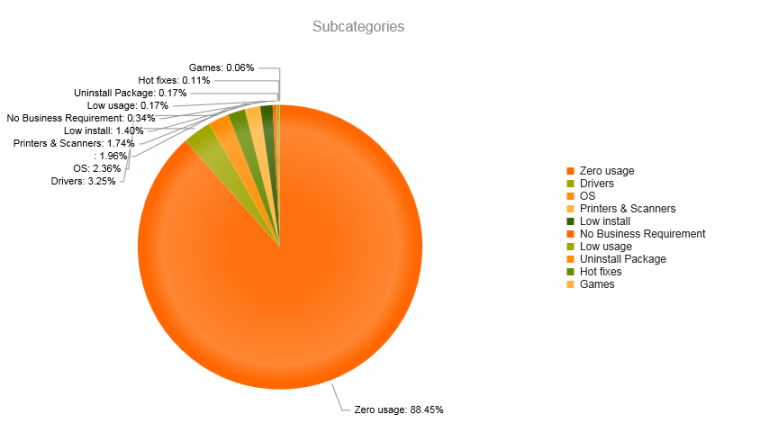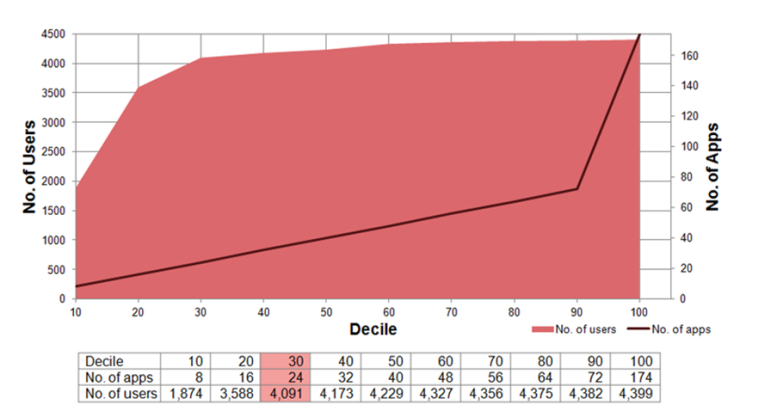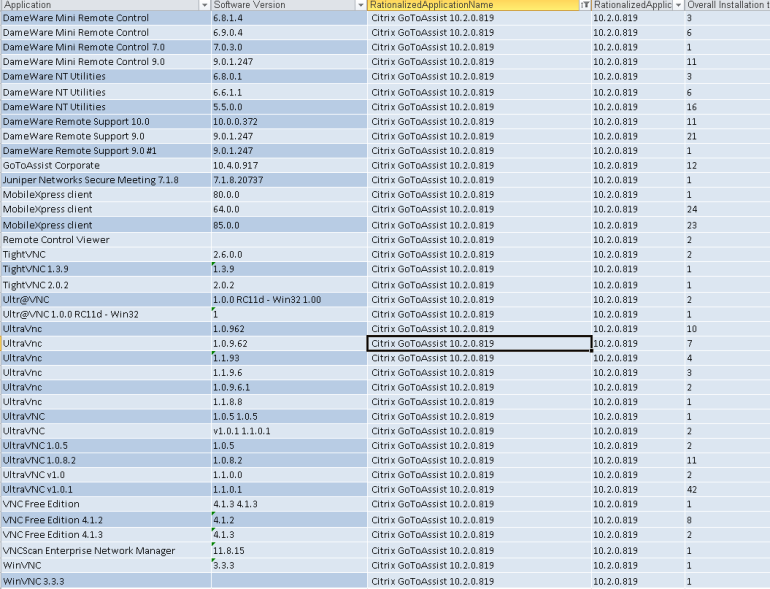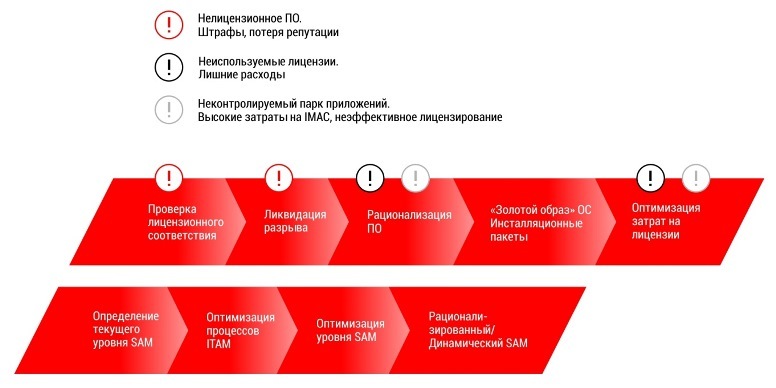Volume Licensing or SAM
In the July article on a centralized approach to managing software assets, we talked about our vision of a holistic application management process, which aims to optimize the cost of licenses, support, software deployment. Having talked about preparing applications for deployment , we now would like to focus on an equally important aspect of software management, namely, license compliance management, that is, Software Asset Management.

Currently, the legislation provides for administrative, civil and criminal liability for the use of unlicensed software. Administrative responsibility is governed by art. 7.12 of the Code of Administrative Offenses and provides for fines for officials who authorized the use of unlicensed software to employees, as well as the removal of programs and computers. Criminal liability for violation of copyright and related rights occurs in the event of major damage to the author or other copyright holder, and the violation is considered as such if the cost of copies of programs exceeds 250,000 rubles. Such violations also provide for imprisonment for up to 6 years with a fine of up to 500,000 rubles. Criminal liability of article 146 of the Criminal Code of the Russian Federation is regulated.
')
The amount of damage is determined based on the number of illegally used copies of the software.
Attracting to the civil liability may occur at the initiative of the author or copyright holder, demanding compensation for damages or compensation. Based on Art. 1301 of the Civil Code of the Russian Federation, the right holder may request compensation from the violator in the amount of 10,000 to 5,000,000 rubles, or twice the cost of the programs, based on the price that is usually charged for legitimate use.
SAM is actively developing in Russia - companies understand that the risks of re-and under-licensing increase significantly when the company is scaled in the absence of proper and competent management, and the SAM approach allows not only to sleep and not be afraid of vendor audit, but also to save significantly.
Even in the case of client software, insufficient maturity of SAM processes in terms of their integration with ITSM and the base of configuration units can form the basis for making wrong decisions that will lead either to the purchase of an unnecessary license (with an existing license, which, for example, is not actively used) or can result in actual under-licensing. Monitor compliance manually, tracking all changes, often in different systems (in practice, server licenses are often kept in Excel files and decentralized, and user licenses can be in a separate Asset Management database that is not integrated with ITSM and CMDB) and making the right decisions when a business requires it is quite difficult. And it is very easy to make a mistake here, because the decision-making basis is often based on information from the CMDB, which can be updated irregularly or with a delay for manual processing. The lack of data links between various sub-organizations and locations, as well as the lack of processes for analyzing software usage and redistributing licenses, leads to tangible financial costs. For example, in different divisions of a company, local IT services record licenses differently: some in the Excel file, others in another Excel file, others in the ITSM system, and the fourth use their local CMDB solution. In one of the units, the user raises an application for software installation. Not finding available copies of the software, the IT service initiates a request to purchase licenses, and in some cases, not only single licenses can be purchased, but also whole volume licensing packages. In this case, it is possible that unused licenses exist in other divisions or even in the same division of the company — the software is installed, but the user does not actually use it in work. Also, by consolidating all the requirements for all departments in software, one could receive more savings on programs of corporate licensing.

Do not forget about Disaster Recovery - infrastructure recovery plan in case of a crash. In order to regain control over the licensing status throughout the environment as soon as possible, it is vital that the data are stored in a database and protected, and the CMDB can always get automatic synchronization with another source, namely the inventory and license database.
In the case of integrating ITSM processes, such as Request Fulfillment (service request management) with the SAM license and process management system, software standardization according to functionality, versions and revisions - that is, software rationalization, software use analysis in the organization, we have accurate and reliable and, most importantly, dynamic software and license data throughout the company, automatically available in the CMDB and in the license accounting system. And this means that all decisions are made on the basis of correct and up-to-date data.

You need to start building SAM processes with the Microsoft SAM Baseline review project, which not only allows you to analyze and get an accurate picture of Microsoft licensing compliance as soon as possible, but also gives you a professional assessment of the maturity level of SAM processes.
Of course, SAM is not limited to controlling the level of compliance with software licenses, and all the more so is not limited to Microsoft software, however, this is a good starting point for starting optimization in your licensed economy.
The basic model of maturity SAM implies 4 levels of maturity:
Such a scheme implies a certain analytical work. For example, for the same rationalization of software used in the company, and control of the process of redistributing licenses. Although this work is quite time-consuming, dynamic and accurate data collected in a convenient form in one place greatly simplify this task, and, consequently, the cost of analyst resources.
With the development of Colibri Application Intelligence Portal, you can significantly reduce the amount of analytical work to streamline data, not only because of data consolidation, but also thanks to the powerful embedded business intelligence of this data.
The solution has a convenient indicator panel, which always keeps in front of, for example, data on the percentage of unused applications, or other customizable categories of software records.

With the help of Colibri Application Intelligence Portal, you can save many analyst working hours on software categorization using pre-configured and customizable patterns, automatically sort garbage, unwanted software, standardize the application on a specific version, and track application usage. Convenient data views, such as Deciles (Deciles), provide immediate benefits from a software migration project: this view offers a partition of users and applications into different groups (10 parts): the first group, for example, will show only those applications that users use.

This presentation of data helps in planning the transfer of the service to outsourcing. For example, it is possible, based on the third decile, to plan the creation of installation packages for 24 applications, and this will cover the needs of 93% of users.
Thus, Colibri Application Intelligence Portal is a powerful tool for scheduling support services, including optimizing time costs for software rationalization, planning changes in software and hardware required for migration projects or outsourcing control of applications.
In the example below, it can be seen that often software of similar functionality can be grouped and replaced by a single software unit, if this is consistent with the requirements of the business and the real reason for installing this or that software.
Suffice it to say that in the case below, Citrix GoTo Assist reduced 39 different commercial software names (taking into account versioning, that is, a unique name-version combination), and this, in this particular case, 250 installed copies of software — that is, licenses.

It is important to understand that products to assist remotely may need a number of licenses that differ from the actual number of software installations. That is, for example, they can be licensed for the number of simultaneously running sessions. Here the statistics of software usage will help you, with the help of which you can estimate the real need for the number of licenses. It is also important to understand that by standardizing the software according to its functionality and version, you can get the benefits of the volume of purchases provided by the vendor, as well as reduce the headache of the support service. Even writing installation instructions takes some time, so do not underestimate the indirect costs.
If we are talking about complex licensing in the data center, on virtualized servers — SQL, Oracle, SAP — the question of analyzing software usage statistics becomes particularly relevant.
For example, after analyzing the nature of the work or the type of transactions in SAP, you can find that users use the expensive version of the product license to perform simple actions, such as: working with time sheets, for which it is enough to allocate much cheaper versions of the license than the Limited Professional used here license.

So, to build the right SAM processes, the following steps are most important:
If we talk about building a dynamic SAM, you can implement these measures in approximately the following sequence:

The upper part is aimed at the most tangible in the short term measures - eliminating the risk of fines and reducing license costs and software support, thanks to the creation of a list of standard software. The measures presented in the bottom row are more “long-playing”, but at the same time, the root factors that will ensure the correct functioning of the organism SAM in all possible situations.
It is worth noting here that the selection of the inventory and license control tools is very important for the successful implementation of SAM projects. There are a lot of solutions on the market now - from simple, offering basic functionality, to complex solutions that are able to cover fully the licensing of client workstations and data processing centers, including complex licensing scenarios. Among them: licenses for simultaneous access, on the number of cores and processors taking into account the specifics of virtualization and other types of licensing, as well as offering “advanced” analytics of software usage. One such solution is the Snow License Manager. The system, in addition to a number of advantages, such as a daily updated database of software definitions, is also distinguished by the rich possibilities of integration with other inventory systems, ITSM systems, procurement management systems and the enterprise. At the implementation stage of the tool and the SAM process, it is very important to think in advance about the need to automate these links, which should be supported by the relevant processes.
In general, SAM is, first of all, a strategy for optimizing software costs in a company, and the solution lies at the intersection of technology, processes, people and analytics. The key role is played by understanding how these components should interact with each other to achieve the desired effect. It is an understanding of all the links in software management that will help to put the bricks in a holistic and slender building that will stand in the face of any upheavals in the field of corporate licensing :)
By ignatyev

Currently, the legislation provides for administrative, civil and criminal liability for the use of unlicensed software. Administrative responsibility is governed by art. 7.12 of the Code of Administrative Offenses and provides for fines for officials who authorized the use of unlicensed software to employees, as well as the removal of programs and computers. Criminal liability for violation of copyright and related rights occurs in the event of major damage to the author or other copyright holder, and the violation is considered as such if the cost of copies of programs exceeds 250,000 rubles. Such violations also provide for imprisonment for up to 6 years with a fine of up to 500,000 rubles. Criminal liability of article 146 of the Criminal Code of the Russian Federation is regulated.
')
The amount of damage is determined based on the number of illegally used copies of the software.
Attracting to the civil liability may occur at the initiative of the author or copyright holder, demanding compensation for damages or compensation. Based on Art. 1301 of the Civil Code of the Russian Federation, the right holder may request compensation from the violator in the amount of 10,000 to 5,000,000 rubles, or twice the cost of the programs, based on the price that is usually charged for legitimate use.
SAM is actively developing in Russia - companies understand that the risks of re-and under-licensing increase significantly when the company is scaled in the absence of proper and competent management, and the SAM approach allows not only to sleep and not be afraid of vendor audit, but also to save significantly.
Even in the case of client software, insufficient maturity of SAM processes in terms of their integration with ITSM and the base of configuration units can form the basis for making wrong decisions that will lead either to the purchase of an unnecessary license (with an existing license, which, for example, is not actively used) or can result in actual under-licensing. Monitor compliance manually, tracking all changes, often in different systems (in practice, server licenses are often kept in Excel files and decentralized, and user licenses can be in a separate Asset Management database that is not integrated with ITSM and CMDB) and making the right decisions when a business requires it is quite difficult. And it is very easy to make a mistake here, because the decision-making basis is often based on information from the CMDB, which can be updated irregularly or with a delay for manual processing. The lack of data links between various sub-organizations and locations, as well as the lack of processes for analyzing software usage and redistributing licenses, leads to tangible financial costs. For example, in different divisions of a company, local IT services record licenses differently: some in the Excel file, others in another Excel file, others in the ITSM system, and the fourth use their local CMDB solution. In one of the units, the user raises an application for software installation. Not finding available copies of the software, the IT service initiates a request to purchase licenses, and in some cases, not only single licenses can be purchased, but also whole volume licensing packages. In this case, it is possible that unused licenses exist in other divisions or even in the same division of the company — the software is installed, but the user does not actually use it in work. Also, by consolidating all the requirements for all departments in software, one could receive more savings on programs of corporate licensing.

Do not forget about Disaster Recovery - infrastructure recovery plan in case of a crash. In order to regain control over the licensing status throughout the environment as soon as possible, it is vital that the data are stored in a database and protected, and the CMDB can always get automatic synchronization with another source, namely the inventory and license database.
In the case of integrating ITSM processes, such as Request Fulfillment (service request management) with the SAM license and process management system, software standardization according to functionality, versions and revisions - that is, software rationalization, software use analysis in the organization, we have accurate and reliable and, most importantly, dynamic software and license data throughout the company, automatically available in the CMDB and in the license accounting system. And this means that all decisions are made on the basis of correct and up-to-date data.

You need to start building SAM processes with the Microsoft SAM Baseline review project, which not only allows you to analyze and get an accurate picture of Microsoft licensing compliance as soon as possible, but also gives you a professional assessment of the maturity level of SAM processes.
Of course, SAM is not limited to controlling the level of compliance with software licenses, and all the more so is not limited to Microsoft software, however, this is a good starting point for starting optimization in your licensed economy.
The basic model of maturity SAM implies 4 levels of maturity:
- Baseline - situational actions to eliminate non-licensing.
- Standardized - there are processes, tools and standards, but the accuracy of the inventory is not high enough, and the data are not used for decision making.
- Rationalized - there are policies, procedures and tools for managing IT assets. Information is reliable and is used for decision making.
- Dynamic - all license management adjusts to the needs of the business in near real-time mode.
Such a scheme implies a certain analytical work. For example, for the same rationalization of software used in the company, and control of the process of redistributing licenses. Although this work is quite time-consuming, dynamic and accurate data collected in a convenient form in one place greatly simplify this task, and, consequently, the cost of analyst resources.
With the development of Colibri Application Intelligence Portal, you can significantly reduce the amount of analytical work to streamline data, not only because of data consolidation, but also thanks to the powerful embedded business intelligence of this data.
The solution has a convenient indicator panel, which always keeps in front of, for example, data on the percentage of unused applications, or other customizable categories of software records.

With the help of Colibri Application Intelligence Portal, you can save many analyst working hours on software categorization using pre-configured and customizable patterns, automatically sort garbage, unwanted software, standardize the application on a specific version, and track application usage. Convenient data views, such as Deciles (Deciles), provide immediate benefits from a software migration project: this view offers a partition of users and applications into different groups (10 parts): the first group, for example, will show only those applications that users use.

This presentation of data helps in planning the transfer of the service to outsourcing. For example, it is possible, based on the third decile, to plan the creation of installation packages for 24 applications, and this will cover the needs of 93% of users.
Thus, Colibri Application Intelligence Portal is a powerful tool for scheduling support services, including optimizing time costs for software rationalization, planning changes in software and hardware required for migration projects or outsourcing control of applications.
In the example below, it can be seen that often software of similar functionality can be grouped and replaced by a single software unit, if this is consistent with the requirements of the business and the real reason for installing this or that software.
Suffice it to say that in the case below, Citrix GoTo Assist reduced 39 different commercial software names (taking into account versioning, that is, a unique name-version combination), and this, in this particular case, 250 installed copies of software — that is, licenses.

It is important to understand that products to assist remotely may need a number of licenses that differ from the actual number of software installations. That is, for example, they can be licensed for the number of simultaneously running sessions. Here the statistics of software usage will help you, with the help of which you can estimate the real need for the number of licenses. It is also important to understand that by standardizing the software according to its functionality and version, you can get the benefits of the volume of purchases provided by the vendor, as well as reduce the headache of the support service. Even writing installation instructions takes some time, so do not underestimate the indirect costs.
If we are talking about complex licensing in the data center, on virtualized servers — SQL, Oracle, SAP — the question of analyzing software usage statistics becomes particularly relevant.
For example, after analyzing the nature of the work or the type of transactions in SAP, you can find that users use the expensive version of the product license to perform simple actions, such as: working with time sheets, for which it is enough to allocate much cheaper versions of the license than the Limited Professional used here license.

So, to build the right SAM processes, the following steps are most important:
- assessment of the current state of license compliance;
- evaluation of the maturity of existing SAM processes;
- choosing the right tool for inventory and monitoring software usage;
- selection of a license control tool;
- software inventory;
- software rationalization;
- optimization of SAM processes in terms of interfaces with procurement management, configuration changes and service requests.
If we talk about building a dynamic SAM, you can implement these measures in approximately the following sequence:

The upper part is aimed at the most tangible in the short term measures - eliminating the risk of fines and reducing license costs and software support, thanks to the creation of a list of standard software. The measures presented in the bottom row are more “long-playing”, but at the same time, the root factors that will ensure the correct functioning of the organism SAM in all possible situations.
It is worth noting here that the selection of the inventory and license control tools is very important for the successful implementation of SAM projects. There are a lot of solutions on the market now - from simple, offering basic functionality, to complex solutions that are able to cover fully the licensing of client workstations and data processing centers, including complex licensing scenarios. Among them: licenses for simultaneous access, on the number of cores and processors taking into account the specifics of virtualization and other types of licensing, as well as offering “advanced” analytics of software usage. One such solution is the Snow License Manager. The system, in addition to a number of advantages, such as a daily updated database of software definitions, is also distinguished by the rich possibilities of integration with other inventory systems, ITSM systems, procurement management systems and the enterprise. At the implementation stage of the tool and the SAM process, it is very important to think in advance about the need to automate these links, which should be supported by the relevant processes.
In general, SAM is, first of all, a strategy for optimizing software costs in a company, and the solution lies at the intersection of technology, processes, people and analytics. The key role is played by understanding how these components should interact with each other to achieve the desired effect. It is an understanding of all the links in software management that will help to put the bricks in a holistic and slender building that will stand in the face of any upheavals in the field of corporate licensing :)
By ignatyev
Source: https://habr.com/ru/post/296298/
All Articles